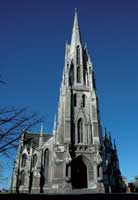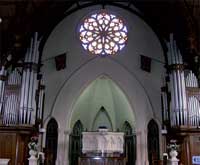Listings for: Dunedin > Activities and Attractions
First Church Heritage Centre
Discover the living story of the settlement at the heart of the city - photos, displays, gifts.
Hours: September-May 10.00am-4.00pm. Winter months (June, July, August) 10.30am-2.30pm
WELCOME TO FIRST CHURCH OF OTAGO
We invite you to come and visit us. Whatever your purpose, (prayer, praise, pausing or taking photographs) please feel welcome.
The First Church of Otago, designed by the architect R A Lawson, was opened on 23 November 1873, just 25 years after the first settlers arrived in Dunedin.
First Church’s purpose is to be a sign of God’s love in the heart of the city. We try to live by the teachings of Jesus Christ and work for a better world which reflects this universal love.
Please take time to enjoy this place. You will be welcome at any of the services especially each SUNDAY at our 10am Morning Worship Service.
If you are here for a short time we hope this guide will help you to appreciate the architectural splendour of First Church and this church’s life whether in worship or hospitality. May the presence of God both comfort and challenge you.
After your visit, please do remember us in your own prayers. Thank you for coming.
Peace be with you. Ministers and Congregation First Church of Otago
SITE
Visitors approaching First Church from Moray Place scarcely realise that the spacious grounds were created by hundreds of men. Convicts worked with pick and shovel to lower Bell Hill 40 feet. The setting of lawns and trees is thus a raised platform with cliff faces on three sides; the spoil from the hill top was used for reclamation of the inner harbour area.
The First Church of Otago, designed by the architect R A Lawson, was opened on 23 November 1873, just 25 years after the first settlers arrived in Dunedin. It had taken six years to complete. Built of creamy Oamaru stone with a base of Port Chalmers stone the church has weathered well. Extensive repairs and reinforcing were necessary in the 1950’s. Major restoration was undertaken in 1991-92 after a nation-wide appeal raised $1,500,000.
INTERIOR
1. PORCH
In the porch, the visitor is surrounded by the story of the history and vision of the Otago Settlement of 1848. There are memorials to Thomas Burns, D.D., first Minister of the Settlement, and to Captain Cargill, first Superintendent of the Province. Other plaques recall R A Lawson, the architect, and Louis Godfrey, the stonemason, whose carving is such a feature of the building inside and out.
2. BELLTOWER
In the 60 metre spire is a ring of Whitechapel bells gifted by Mr H H Richmond and installed in 1975. Tunes can be played on the 12 bells from the clavier. Eight of the bells are hung for traditional change ringing by members of the Society of Change-ringers. The bells are regularly heard before the 10am Sunday services and at other times. There is no public access to the belfry except on notified demonstration occasions. It is understood that outside Britain this is the only Presbyterian Church in the world to have change ringing.
3. SANCTUARY
The layout of the interior is typical of Presbyterian churches of the 19th century. The gallery was added after the church was opened and a motif combining thistle, rose and shamrock is carved along the face of the gallery.
4. PULPIT
The pulpit was originally a slender third of its present size, but was enlarged in keeping with the preacher’s taste early this century. The Dove of Peace is clearly visible beneath the pulpit reading desk. The carving on the pillars flanking the pulpit depict Life and Death.
5. THE CHANCEL
The arrangement has varied over the years. In 1967 balustrades and organ console were removed.
6. THE ORGAN
Organ music was not acceptable when the church was opened, but a water powered organ was installed in due course. The pipe organ installed in 1908 was modified twice (in the 1930s and 1960s). An Allen digital organ was installed in 1982.
7. THE ST ANDREWS AISLE
In 1978 St Andrew’s, a church noted for the ministry of the Rev Dr Rutherford Waddell, preacher, author and political reformer, also merged its membership with First Church. The left Transept, where evening services are held, is now known as St Andrew’s Aisle.
WINDOWS
The Rose Window (high above the pulpit) is so named because of its circular shape and because the radiating strips of lead resemble “petals’.
The Soldiers’ Memorial Window was unveiled in 1923. It is divided into four subjects:
Top Left - A Christian Knight arming for battle with the three Graces in attendance.
Top Right - Christ holding a Crown of Victory. On the left is a Guardian Angel and on the right two New Zealand soldiers.
Lower Left - Roman soldiers “beating their swords into ploughshares”
Lower Right - The shepherds receiving the Message of Peace.
The flags are Otago Regimental colours.
TAPESTRY
In the right transept under the window is a tapestry which depicts the story of the settlement of Otago in 1848.
Panel 1: is of two churches in Scotland, Prestwick and Monkton, where Thomas Burns was minister before coming to Dunedin.
Panel 2: is a pillar of light representing Christ accompanying the two ships John Wickliffe and Philip Laing bringing the Scottish settlers to Otago.
Panel 3: is of First Church with a background of city houses and the countryside.
This tapestry was designed and supervised by Jan Wilson of Otago Polytechnic and was stitched by nineteen women of the Church over 6000 hours in 6 years. The panel which was started in 1983 was unveiled in 1990 and coincided with the 150th Anniversary of the establishment of the Presbyterian Church in New Zealand.
MORAY HALL
In designing the church R.A Lawson included a parish hail attached to the rear of the building. When the 100-year-old Moray Place Congregational Church came to join with First Church, the union was symbolised in the re-decoration and renaming of this room as the Moray Hall and the incorporation of their stained glass windows in 1967. This room is now a Heritage and Visitor Centre.
Samoan and Cook Island members, formerly Congregationalists, today form part of this congregation and meet for worship in their own languages.
EXTERIOR
As the visitor walks round the outside of the church, they will again notice Godfrey’s handiwork in the small faces, leaf patterns and dragons placed in pairs on each side of the upper windows and in other carving detail. The fine bracket lamps towards the rear of the church and the lamp-post on the lawn at the front are old Edinburgh street lamps gifted to the church.
GROUNDS
The bell in the church grounds was an early gift of friends in Scotland to the Minister and congregation of First Church and was used for many years to regulate the working time of the community. Burns Hall to the right of the church was built in 1908 and renovated in 1991.
The spacious grounds and fine trees are part of the heritage of all citizens of Dunedin.
OPEN 10am - 4pm MONDAY to SATURDAYS
HERITAGE AND VISITORS’ CENTRE (Moray Hall)
To commemorate the role and importance of First Church of Otago in the establishment and development of Dunedin a Heritage and Visitors’ Centre was set up in Moray Hall as an ongoing testimony to the past and the present.
• To discover the history at the heart of Dunedin, visitors are urged to visit the Centre when it is open. You will enjoy the:
• pictorial displays
• details about Thomas Burns and others
• Ship passenger lists, other registers
• story of Bell Hill and more
• postcards and other mementoes are available.
1848 marked the beginning of Dunedin as a Free Church of Scotland (Presbyterian) settlement. The early settlers formed the beginning congregation or First Church of Otago with The Reverend Thomas Burns as their Minister.
In 1998 First Church of Otago and Dunedin celebrated 150 years of settlement. 1998 also marked 125 years since the opening of this fine church in November 1873.
Prayer for use before you leave the Church
Lord, Our God,
in the quiet of this house,
conscious of so much history,
yet surrounded by the sounds and sights of the city of today
and aware that we are travellers who seek a city yet to come,
we open ourselves to Your living presence.
Give us a mind steadfast in Your hope,
Give us the strength of Your Spirit,
Give us the gift of sympathy,
Give us the joy of serving You and others for You.
Bless those who worship and witness here
and everywhere.
 |
 |
 |
 |
| Address: | 415 Moray Place ,Dunedin | ||
| Phone: | +64 477 7150 | ||
| Map Reference: | |||
| GPS coordinates: | -45.87604,170.504774 | ||
| This Site © A To Z Publications Ltd, New Zealand, 1997 - 2025. Enquiries to info@atoz-nz.com |
